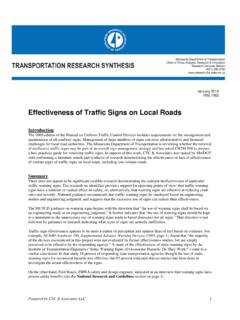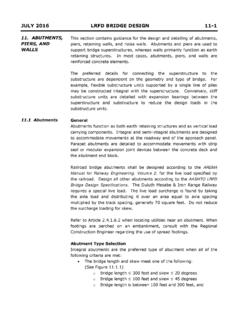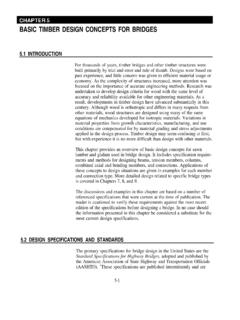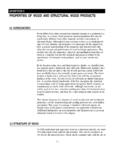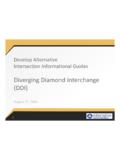Transcription of EVALUATION OF THE IMPACT OF REDUCED CONFLICT …
1 EVALUATION OF THE IMPACT OF REDUCED CONFLICT INTERSECTIONS ON. truck AND LARGE AGRICULTURAL VEHICLE CRASHES. 1. INTRODUCTION. Rural multi-lane divided highways provide mobility and safety to the traveling public. This type of roadway is generally characterized by higher posted travel speeds and lower densities of intersections (which are typically at-grade and require only the side street motorists to stop). In some cases, this combination of multiple lanes of high speed traffic, the at-grade access, and driver performance can result in right angle collisions which are much more severe than found at smaller two-lane roadway at-grade intersections.
2 Maze et al. (2010) reported that 57% of the intersection related crashes in Minnesota were right angle or turning crashes with similar results in Utah (69%) and Iowa (52%). These at-grade intersections along multi-lane roadways present challenging conditions for drivers in terms of judging gaps between high-speed traffic from two different directions separated by a median. Comprehension and understanding on whether to stop within the median or cross the intersection in one movement has shown to be problematic for drivers along with a persistent stop compliance issue seen particularly in rural settings (Maze et al.)
3 , 2010). Some states have begun to address crash or the potential for crash at such intersections through physically restricting vehicle crossing movements (across the median) thus simplifying driver decision making in terms of gap acceptance. These access limiting treatments are referred to be several names including Restricted Crossing U-Turn (RCUT), J-Turn, and as in this report and the Minnesota DOT the REDUCED CONFLICT intersection (RCI). RCIs prohibits conflicting movements at an intersection through redirecting the side-street left/through movements and often times the major roadway left turn as well.
4 The side-street movements are accomplished indirectly through requiring that the side-street motorists turn right onto the main roadway and then make a U-turn maneuver at a one-way median opening roughly 400 to 1,000 ft away from the intersection . While effective in controlling crossing maneuvers, and consequently preventing severe right- angle crashes, the RCI intersection requires additional maneuvers for side-street motorists. Within Minnesota's rural corridors, introduction of the RCI design has been successful in preventing severe crashes, however, the unusual design has been met with some apprehension from operators of agricultural equipment and large trucks.
5 This, in combination with a resistance to the unfamiliar, has created a desire for more information regarding RCI intersection configuration safety impacts for these types of vehicles. This study reviews the crash performance of RCI intersections within Minnesota and three other states to consider if RCIs negatively IMPACT the safety for large vehicle types (large trucks and ag-equipment). Background One promising strategy for mitigating right angle crashes is use of an RCI. This design restricts minor road vehicles from making left or through movements.
6 Instead, these vehicles have to make a right turn and travel a short distance downstream on the major road and then execute a U- turn. Drivers intending to turn left then continue on the expressway and drivers who intended to cross the intersection , then make a right turn. Turning traffic from the major roadway can be accommodated in two different ways. A J-turn is a variant of the RCI intersection where left turns from the major road are allowed while the minor road through and turning movements are restricted and will have to use a U-turn (Hughes et al.)
7 , 2010). Figure 1 shows a typical J-turn. This type of intersection has been used in 1. Michigan as well as other states successfully for more than forty years (MDOT, 2010). A basic RCI intersection with no direct left turns is another variant of RCI in which drivers from the main road intending to turn left will have to make a U-turn maneuver at the median crossover and then turn right into the minor street. The left turn and through movements from the minor road are also routed through the U-turn crossovers (Hughes et al.
8 , 2010). Figure 1: J-turn intersection Source: FHWA, 2009. The RCI design reduces CONFLICT points. A typical two way stop controlled intersection has 42. total CONFLICT points while a J-turn has only 24 CONFLICT points as shown in Figure 1. The most severe crossing conflicts that can result in right angle crashes are eliminated (Maze et al., 2010). However, concerns have been raised in Minnesota that as large trucks make the U-turn maneuver they are occupying travel lanes for a longer period of time than would be required for a side street left-turn or through maneuver and consequently are more exposed to on-coming high speed vehicles.
9 Safety IMPACT of the REDUCED CONFLICT intersection The following summarizes current literature regarding the safety IMPACT of RCI intersections. It should be noted that different geometric designs are utilized so results across different studies are not necessarily comparable. A study by Inman and Haas (2012) compared crashes for nine intersections in Maryland before and after installation of RCIs. Six of these intersections existed on 15, and three existed on 301. Crash data were obtained from the Maryland State Highway Administration which included crash locations, date, time and severity of crashes at the intersections.
10 Nineteen years of crash data were obtained for six intersections located on 15. Twelve years of crash data were available to three intersections along 301. Before and after comparisons of traffic crashes were made for each main intersection of the RCI, the sections between the RCI and the U-turn locations. An Empirical Bayes analysis was conducted for the nine intersections and found a 62% decrease in crashes after the RCI treatment was installed. Crashes decreased on the adjacent highway segments was decreased by about 14% and an overall decrease of 44% was reported.
